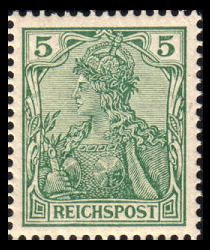 | ||
Germania stamps are definitive stamps that were issued by the German Empire and the Weimar Republic between 1900 and 1922, depicting Germania. They represent the longest running series in German philately and are in their many variations and derivations an essential part of German philatelic collections.
Contents
Design
The initial issue from January 1, 1900, replaced the standard issue depicting numbers and eagles. The image of Germania, rather than that of the ruling monarch as was customary in many other European monarchies, made it a unifying feature and did not complicate the relationship with other German royalty and the coexisting German postal authorities of Bavaria and Württemberg. The engraving was performed by Paul Eduard Waldraff (1870–1917) who used the actress Anna Führing as model. Wearing an octagonal imperial crown she is holding a sword and an olive branch. The Jugendstil design depicting Führing was personally chosen by the emperor Wilhelm II.
Issues inside Germany
The Germania stamp has many issues and variations. The 1900 issue is inscribed "Reichspost", all issues after April 1, 1902, carry the "Deutsches Reich" (German Empire) inscription. All issues after 1902 have watermarks. Within Germany Germania stamps were issued as follows:
German Empire
Weimar Republic
Disputed areas
Issues outside Germany
Overprinted Germania stamps were used outside Germany. Prior to World War I they were released by German post offices abroad in a number of foreign countries, namely China, Morocco, and Turkey. During the First World War Germania stamps were released in occupied areas, namely in Belgium, France, "Postgebiet (des) Ob(erbefehlshabers) Ost" (eastern postal territory), "Russian Poland", "General-Gouvernement Warschau", and Romania. After the war, the stamps were also initially used with overprints in Danzig. Further, Polish postal authorities, Poczta Polska, also initially utilized overprinted Germania stamps.
One of the rarer German stamps is the Vineta provisional, a halved and overprinted Germania stamp that was issued by the cruiser SMS Vineta in 1901.
Germania stamps were not issued in the German colonies, instead in those territories the Yacht issue was released first in 1900 with the appropriate identifying inscriptions.
Postal stationeries
From 1900 onwards the Deutsche Reichspost issued several postal stationeries with imprinted Germania stamps. The most common one is a ‘Postkarte’ (postcard) with an imprinted 5 Pfennig stamp. In 1916 the German government introduced a tax on the postal traffic, the Reichsabgabe. This involved a raising of the postal rates and the 5 Pfennig postcard was replaced by a 7½ Pfennig postcard. In 1918 the Reichsabgabe was raised. Now the 10 Pfennig postcard for international mail had to be used for domestic mail too.
Postal stationeries with imprinted Germania stamps have been overprinted for the use in a.o.:
In short, the postal stationeries with imprinted Germania stamps were almost as widely used as the stamps themselves.
